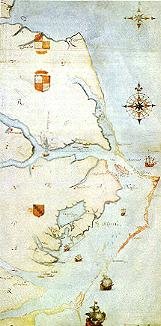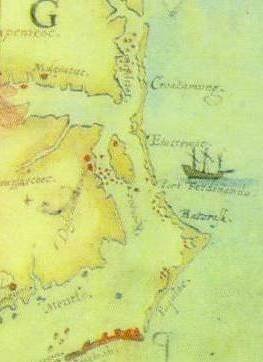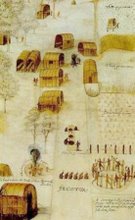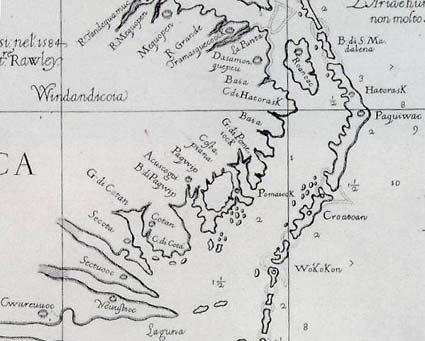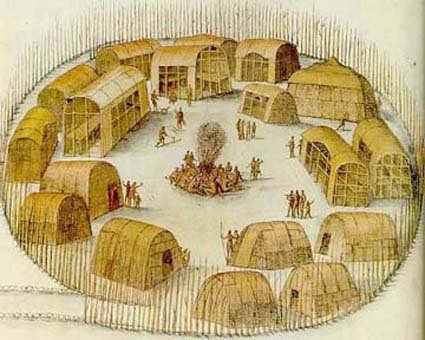Lesley Stahl reports on the new field of genetic genealogy, which uses DNA to trace ancestry back hundreds of years. (This story was first broadcast on Oct. 7, 2007, rebroadcast June 29, 2008.) You can view it here:
http://www.cbsnews.com/sections/i_video/main500251.shtml?id=3340379n
Monday, June 30, 2008
Finding One's Roots
Posted by
Historical Melungeons
at
6/30/2008 01:55:00 AM
![]()
Labels: African DNA, Genetic Genealogy, genetic testing
Saturday, June 28, 2008
Genealogy by DNA: Can it Deliver?
by Janet Crain
This article is not intended to criticize the geneticists involved in this new science. Henry Greely, a professor of law who specializes in genetics and ethics at Stanford University in California says;"I know these scientists, and they are honorable people, and the reports they give don't overpromise". Some firms require clients to sign psychological releases absolving companies from responsibility if results don't jibe with client expectations.
However; Bruce Jackson, a molecular geneticist at Boston University, who has launched the African-American DNA Roots Project, along with biologist Bert Ely of the University of South Carolina, cautions that "like anything on the Internet, this is all a case of 'caveat emptor' - let the buyer beware. But the science is valid. There's no doubt about the science." He sees DNA as "the hottest new tool" in genealogy, which is why Web sites on the subject run second only in hits to pornography pages. With those kind of statistics, it is easy to see that this "hot new tool' is going to be marketed and hyped to the hilt.
Unfortunately, sometimes the hype exceeds the actual benefit that can reasonably be expected to accrue. Minorities, in particular, are targeted. Because most black African Americans do not know what part of Africa their ancestors came from, or what tribe, they are immensely interested to find out anything that will give them a connection to their mother country. So is learning that you have a genetic marker that is shared by a widespread group of people in Africa worth $349.? That would, of course, depend on your curiosity and finances. Is the hype promising a greater benefit than can be delivered?
Some bio-ethicists say the sales pitch raises unreasonable expectations. "DNA is going to be very important and it’s on the cutting edge,” said professional genealogist Tony Burroughs, who teaches at Chicago State University. “But it’s not a panacea. You’re not going to discover your entire family tree from a little spit on a cotton swab.”Burroughs, author of “Black Roots: A Beginners Guide to Tracing the African American Family Tree” argues that DNA can’t replace old-fashioned reporting work.But rather, he feels genealogical breakthroughs will come from uncovering previously forgotten written records. He’s after names, addresses and other hard facts.
Another group that is often targeted by testing companies is Native American Indians. There are many people in the Americas who descend from the Native American Indigenous peoples of these continents. Some know it, some suspect it, some have no idea. The suppression of knowledge about Native American bloodlines was a direct effect of government policies since Europeans first set foot on North and South American. It is now believed that, the diseases, unwittingly carried by the Europeans, wiped out about 75-95% of the original population. The remaining population was systematically cheated and dispossessed, until only remnant bands remained and these were herded onto reservations or relocated to distant lands. The so called Trail of Tears separated many families. Other similar sad events had the same consequences. Many Native Americans assimilated and intermarried with whites. Traders and early day hunters were eager to take Indian wives to gain access to rich hunting grounds. The descendants of these dispossessed people often had no way to unravel their true genetic heritage. In the late 19th century, it wasn't a popular thing for parents to pass on to children. Some had a vague idea or heard rumors, but there was nothing substantial to go on.
Now there is. For as little as $99.00, a male in a surname group can learn if his Y chromosome paternal line is Native American. Similarly, a woman or a man could take the mtDNA test (group priced at $129. or as low as $89. for existing Family Tree DNA customers), and learn if their straight-line maternal line is Native American. Several different testing companies offer reductions in price to participants in surname groups of at least six. The problem with both Y and mtDNA testing is that due to racial mixing, a person's paternal line; father's father's father's, etc. may lead back to a European man and the maternal line; mother's mother's mother's may lead back to a European woman. This can hold true in some cases for a person who looks entirely Native American. One Native American man from Canada discovered that not only is he descended from an Englishman on the Y chromosome, but he is eligible for some hereditary position in England. Other than finding out you are really an English Earl with a castle in England (and a substantial inheritance), this type of result would disappoint many.
One of the better known media hyped DNA tests was that of the Melungeons, a dark skinned group of unknown origin living in Tennessee in the early 1800's. These DNA tests were started about 2000, as a volunteer effort; there was no cost to the participants except unfulfilled expectations, frustration and time lost. After many promises of the results being announced, there was finally an announcement, of sorts, on June 23, 2002. Were the expectations met? Without pointing a finger of blame at any one person, I would have to say; "No". For several reasons. The announcement only included preliminary results and comments. No actual DNA raw data was ever presented to participants or anyone else. No known peer review was ever conducted. No questions were answered conclusively. It was called a "Population" test, but only had around 100 participants. Its purported purpose was to capture a view of the Y chromosome and mtDNA haplogroups carried by these few self identified Melungeon descendants that came down to them from their Melungeon foreparents. Even though several generations had passed and their ancestry now had the input of many other ancestors, this was supposed to offer some information. Yet to this day, the "results" of this test are quoted as if they are valid.
Regrettably this lucrative new field has attracted some so called "experts" whose only talents consist of cutting and pasting together impressive looking reports. In my opinion, their professional background should be investigated thoroughly before investing in their interpretation of your DNA data. Many good people are involved in the new science of Genealogy by DNA. Quite a few are donating their time and expertise. It would certainly be to the DNA test subject's advantage to join a list of persons researching this area and learn all you can before spending your hard earned money on consultations with "Internet" experts. Once you are better informed you can make better decisions as to how the allocate the funds, if any, you decide to budget for this expenditure.
The latest player among DNA tests is the autosomal test. This type of test, tests the DNA inherited from both parents and shuffled during transmission. It was thought that certain genes would be informative to determine ethnic percentages. These tests were highly touted for this ability, but soon found lacking. What the DNAPrint test can do is predict majority ethnicity. And that is very important for forensic purposes. When the FBI profiled a serial killer in Louisiana as a white loner type, the DNAPrint test revealed him to be predominantly black. This new information led to his arrest and possibly saved lives of future victims.
However the hype surrounding this test, claiming to be able to detect as little as 3% of an ethnicity has led many people to believe, erroneously, that they have an ancestor of a previously unsuspected ethnicity when, in actuality, they do not. Experts say the test is only accurate to + or - 15%.
Recently a utility named OmniPop became the cause celebre among some DIY geneticists. But the creator, Brian Burritt, has stated he never intended this utility to be used for this purpose. And it would be very misleading if used in this manner. In addition, Family Tree DNA has issued a statement cautioning against reliance on this utility. An excellent service now available is http://www.dnaexplain.com/.
So, in conclusion the answer to "Can Genealogy by DNA Deliver?" is a qualified "Yes". Just be sure you have a clearly defined objective; more than one objective is fine. Do your homework and learn the limitations of Genealogy research utilizing DNA testing. And be sure you are using the right test to answer your questions. Don't be embarrassed to ask questions of those more knowledgeable than yourself. Most of us knew little to nothing about this new Genealogy tool when we first became interested. The technology is very new. It is changing at a dizzying speed. It is cutting edge. It can be tedious waiting for results. It can be disappointing when the results are not to your expectations. But the rewards are many and very exiting for those who understand these obstacles. And you will surely have something to talk about at your next Family Reunion.
More here:
http://www.genpage.com/genealogyDNA.html
Posted by
Historical Melungeons
at
6/28/2008 04:49:00 AM
![]()
Labels: African DNA, autosomal, Melungeon
Wednesday, June 25, 2008
'Lost Colony' has brand-new old clothes
Tony-winning designer made sure each outfit has the aged look it needs.
By Martha Waggoner
Associated Press
RALEIGH --Two days before opening night of “The Lost Colony,” Tony award-winning designer William Ivey Long was still working on costumes. They were all new, but had to look very, very old.
“The Lost Colony” tells the true story of an English settlement founded in 1587 on North Carolina's Outer Banks whose colonists mysteriously disappeared.
And so, Long was at it with cheese graters and rasps, aging the costumes that he and his staff had created. The costumes were made to replace more than 1,000 outfits destroyed in a fire last fall at the Waterside Theatre in Manteo, not far from the site of the original colony on Roanoke Island.
“This has been the greatest challenge and, for me, the greatest assignment of my entire life,” said Long.
It seems implausible that work on a regional outdoor drama could top the five Tonys that Long has won for his costume work in “Hairspray,” “Grey Gardens,” “The Producers,” “Crazy for You,” and “Nine.”
But Long, who donated his time and labor to “The Lost Colony,” has been affiliated with the show his entire life. His father was technical director for “The Lost Colony,” and Long was 8 when he first performed as a colonist boy.
He dyed and mottled the clothes himself before moving on to tear the sleeves, hems and, for the men, the knees, to age the clothes the colonists wear in the final scenes before they disappear.
“The Lost Colony” production, which has been performed each summer at the Waterside since 1937, bills itself as the nation's longest-running symphonic outdoor drama. Producer Carl Curnutte said the show was bound to return despite last year's blaze, which caused more than $2.7 million in damage. The cause of the fire remains undetermined.
http://www.charlotte.com/breaking_news/story/684671.html
Posted by
Historical Melungeons
at
6/25/2008 02:47:00 PM
![]()
Labels: citee of raleigh, lost colony, manteo, outdoor drama
Tuesday, June 24, 2008
23andMe to California: We're Not Ceasing or Desisting
Janet Crain
=============================================
By Alexis Madrigal June 24, 2008 11:39:04 AMCategories: Genetics
After being hit with a cease-and-desist letter by California's Public Health Department, the highest-profile direct-to-consumer genetic testing company, 23andMe, shot back today that they'll be doing neither.
"We believe we are in compliance with California law and are continuing to operate in California at this time," the company said in a statement released to Wired.com.
23andMe is one of thirteen companies that had until yesterday to respond to identical cease-and-desist letters from the health department. Navigenics, DNATraits, and HairDX also received letters Wired.com has confirmed. The Health Department plans to release the names of the rest of the companies today on its website.
In the full statement 23andMe released, it's unclear exactly what legal tack the company is going to take in fighting (or working with) the health department. But they make clear that they do not believe that the Health Department is applying the "appropriate regulatory framework" to their business:
CGC Genetics, deCODEme, Gene Essence, Knome, New Hope Medical, Salugen, Smart Genetics, and Suracell were issued cease-and-desist letters two weeks ago along with five companies Wired.com had previously confirmed, Navigenics, 23andMe, DNATraits, HairDX, and Sciona.
The latest announcement means that all three high-profile genome scanning companies -- deCODEme, Navigenics, and 23andMe -- received notices from the state.
Posted by
Historical Melungeons
at
6/24/2008 11:50:00 PM
![]()
Labels: DNA, DNA Projects, Genetic, Genetic Genealogy, genetic testing
Monday, June 23, 2008
Ribbon of Sand cont.
Customer Reviews:
- Anyone who has visited the Outer Banks -- and many who have only seen them from the famous 1970-era Apollo space shot -- knows that the islands are unique, fragile, and someday going to be overrun, either by trashy tourism or, eventually, nature. Alexander and Lazell hope, but are hardly convinced, that nature will get the chance to run its long course. Beyond the fascinating subject, the authors' chapter by chapter analysis of the forces that compete on the Banks -- sand, wind, land, forest -- is a clarifying approach to writing about the science of the Banks.
- Ribbon of Sand captures PERFECTLY the true mystique of North Carolina's Outer Banks -- how a half-mile wide band of barrier islands survive both because of nature . . . and in spite of it. Each segment of the book ties together both human and natural history.
- It is an amazingly interesting and informative book. Geology, geography, biology, weather, ecology, politics, and more are all discussed as is the importance of each in relation to the others. I found the book engrossing and would recommend it even if you are not going to this unique area of the world. Now when the kids ask me why there is a forest in the dunes I will be able to tell them and I will be much better able to appreciate the beauty of the place.
Posted by
Historical Melungeons
at
6/23/2008 05:50:00 PM
![]()
Ribbon of Sand

Outer Banks
From Wikipedia, the free encyclopedia
The Outer Banks are a 200-mile (320-km) long string of narrow barrier islands off the coast of North Carolina, on the East Coast of the United States. They cover approximately half the northern North Carolina coastline, separating the Albemarle Sound and Pamlico Sound from the Atlantic Ocean.
The Outer Banks are a major tourist destination and are known for their temperate climate and wide expanse of open beachfront.
The Wright Brothers' first flight in a powered, heavier-than-air vehicle took place on the Outer Banks on December 17, 1903, at Kill Devil Hills, near the sea-front town of Kitty Hawk. The Wright Brothers National Monument commemorates the historic flights, and First Flight Airport is a small, general-aviation airfield located there.
An English colony—where the first person of English descent, Virginia Dare, was born on American soil [1]—vanished without a trace from Roanoke Island in 1587. The treacherous seas off the Outer Banks and the large number of shipwrecks that have occurred there have given these seas the nickname Graveyard of the Atlantic. The Graveyard of the Atlantic Museum is located in Hatteras Village near the United States Coast Guard facility and Hatteras ferry.
http://en.wikipedia.org/wiki/Outer_Banks
North Carolina's Outer Banks separating the Atlantic Ocean (east) from Albemarle Sound (north) and Pamlico Sound (south). Orbital photo courtesy NASA.
Posted by
Historical Melungeons
at
6/23/2008 02:26:00 AM
![]()
Labels: Albemarle, hatteras, outer banks, Pamlico, roanoke, virginia dare
Sunday, June 22, 2008
Lost Colony was the First of the Tarheel Mysteries
The legends and stories of North Carolina are infinitely fascinating. In 1946 and 1947, John Harden hosted a radio show called Tales of Tarheelia, in which he recounted many of the state's legendary stories and mysteries. Interest in that radio series and Harden's commitment to preserving these stories that could be lost forever if not put down in writing led to the publication of this book, The Devil's Tramping Ground and Other North Carolina Mystery Stories, in 1949. The stories collected here are mysteries as opposed to, say, ghost stories (of which North Carolina can boast of her fair share); these stories won't give you the creeps, but they will fascinate you and sharpen your interest in the history of the state of North Carolina.
When you talk about North Carolina mysteries, you must start at the very beginning - the Lost Colony. The first English settlement in the New World was made in the late 16th century at Roanoke, and it was here that the first non-native American child was born (Virginia Dare); when John White and the long-delayed supply ship returned to these shores, the entire colony had disappeared completely, leaving behind a single clue as to the colonists' fate: the carving of the word Croatoan on a tree. This, North America's first mystery, remains as compelling and unsolved today as it was over four hundred years ago.
Posted by
Historical Melungeons
at
6/22/2008 11:00:00 PM
![]()
Labels: Croatan, lost colony, roanoke, tarheel
Saturday, June 21, 2008
Genealogy Blogs Have Much to Offer
A genealogy blog? What's that?
A “blog” is one of those made up words coined by the Internet.
Click here to see the Wikipedia definition.
Click here to visit the GenealogyBank.
Here are some blogs that come highly recommend. They are each must read sites.
Ancestry Insider
This well informed blogger’s daily posts are focused on Ancestry.com and familysearch.org Knowledgeable and on target it is a must read blog written by an Ancestry employee – BUT it is not an “official” corporate blog.
DearMYRTLE’s Genealogy Blog
DearMYRTLE has been working in genealogy for decades. Her blog is essential reading and can be counted on for breaking news and insight. Count on her to make new resources easy to use and understand.
Eastman’s Online Genealogy Newsletter
Dick Eastman’s blog is essential reading. Dick is up to date and knows the field. His blog comes in two flavors – free and a paid version. You’ll want to pay the nominal fee and subscribe to his blog - it’s worth it.
Everton Publisher’s Genealogy Blog
Leland Meitzler posts 3-4 times a week and puts his decades of experience to work in reporting what is happening in genealogy. Leland has the pulse of the field and hey, he’s a heck of a nice guy too.
The Footnote Blog
This blogger usually posts 2-3 times a month. The articles are usually brief and focus on the latest developments at Footnote.com – you’ll want to read it to keep up with what’s new on that site.
Genealogy Insider
Diane Haddad, Editor of Family Tree Magazine is a great blogger. Well informed and with an upbeat writing style. Haddad is essential reading. Don’t miss this blog – its terrific.
http://blog.genealogybank.com/
Posted by
Historical Melungeons
at
6/21/2008 05:42:00 PM
![]()
Labels: Blog, Genealogy, genealogy blog
Friday, June 20, 2008
10 Days Only Sizzling Hot Opportunity to Upgrade Y Chromosome Markers
The following letter was sent to all Family Tree DNA project administrators:
Family Tree DNA has been an industry leader in helping families find lost connections. As a result, the size of our database is unmatched and has achieved critical mass, allowing more and more family members and even adoptees or descendants of adoptees to find their biological paternal lines, including the surname of the original family. Are there missing (participants) among these adoptees looking for their connection to this direct paternal line?
In an effort to help answer that question Family Tree DNA is offering, for the first time ever, a discount on all Y DNA upgrades! We will be notifying each participant in the database who qualifies for this offer by email, and will provide them a direct link they may use to take advantage of this upgrade. There will be no need for participants to contact us directly in order to receive the reduced price; our prices will be adjusted in the system accordingly.
The offer will be from June 20th to June 30th. During this time, Family Tree DNA will reduce all of our Y-DNA upgrade prices. On average, the reduced prices will be 25% lower than the original upgrade price.
This is a great opportunity to increase the data in your surname project. Are there members who have been hesitant to upgrade due to price? This rare discount is an opportunity for them to upgrade and help both their group and potential lost relatives at the same time. When encouraging members to upgrade, you may wish to note that genetic matches allow people to find their biological lines rather than a specific individual.
This promotion is for upgrades only and does not apply to new kit orders. It’s our way to thank past customers for their patronage.
As always, we appreciate your continued support.
Family Tree DNA
=============================================
This is a fantastic opportunity and one not likely to be repeated, so if you have already Y-tested or sponsored someone at some level with Family Tree DNA, go to the personal page and order an upgrade as usual. The new pricing schedule is already in effect and visable.
Notices have been sent to all participants, but some email contact info is no longer current.
~History Chasers
Posted by
Historical Melungeons
at
6/20/2008 04:02:00 PM
![]()
Labels: African DNA, ancestry dna, Genetic Genealogy;family tree dna
Thursday, June 19, 2008
Confusion Abounds over California's Intent
Will California's Letters to Genetic Testing Companies Affect Genealogists?
Posted by Diane
California's attempt to regulate genetic testing has raised a bit of a stir in the genealogical community, but it's unclear whether genetic genealogy tests will be affected.
Wired reports that the state department of public health sent sternly worded cease-and-desist letters to 13 DNA testing companies warning they’re in violation of California law.
California requires labs that are located in the state or process biological samples originating there to get a state laboratory license, and it also prohibits direct-to-consumer clinical lab tests without a doctor’s order.
One warning letter, linked in Wired’s article, specifically states genetic tests are not exempt. But it doesn’t distinguish between genetic genealogy tests (such as Y-DNA tests) and disease-related genetic tests (such as 23andMe’s genotyping services).
Genetic genealogy company FamilyTreeDNA didn’t receive a letter, spokesperson Bennett Greenspan told me, but the company’s disease-related testing business called DNA Traits got one (now posted on Wired). And from the letter's wording, it looks like the state’s concern is tests that reveal medical information without involving the consumer’s physician.
The California Department of Health hasn’t yet returned my call seeking clarification. Meanwhile, the letter demands recipients cease and desist offering genetics tests to California citizens.
http://www.familytreemagazine.com/insider/
Posted by
Historical Melungeons
at
6/19/2008 10:17:00 PM
![]()
Labels: DNA, Genetic Genealogy





